Report on Advanced Non-Associated Plasticity and Hardening
VerifiedAdded on 2023/01/12
|15
|5514
|2
Report
AI Summary
This report presents a comprehensive analysis of advanced non-associated plasticity with enhanced isotropic and non-isotropic hardening, focusing on its application to sheet metal. It begins with an introduction to anisotropic metal plasticity and ductile fracture, highlighting their importance in industries like automotive and military engineering. The report explores various phenomenological models and yield functions, including the Yld2000-2d yield criterion, and discusses experimental characterization and numerical implementation. The study includes the analysis of AA6260-T6 aluminum alloy and the use of finite element simulations to validate the constitutive models. The report also addresses the challenges in modeling rolled aluminum sheets and explores models that account for anisotropy, such as Gurson-type models and continuum damage mechanics models. The thesis covers constitutive modeling, experimental characterization, and numerical implementation, with chapters dedicated to specific topics, including the experimental characterization of AA6260-T6 and the development of yield functions for three-dimensional stress states.
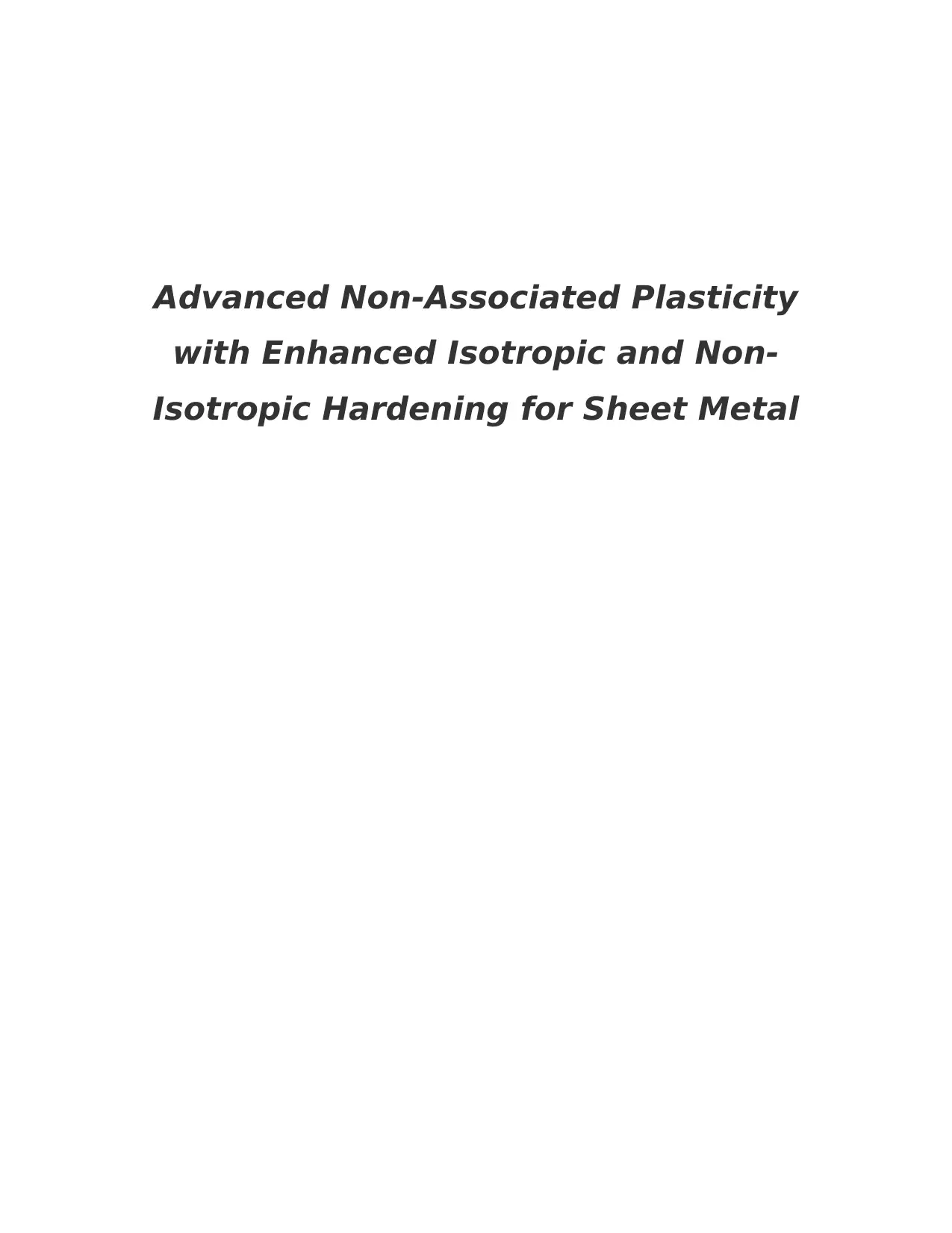
Advanced Non-Associated Plasticity
with Enhanced Isotropic and Non-
Isotropic Hardening for Sheet Metal
with Enhanced Isotropic and Non-
Isotropic Hardening for Sheet Metal
Paraphrase This Document
Need a fresh take? Get an instant paraphrase of this document with our AI Paraphraser
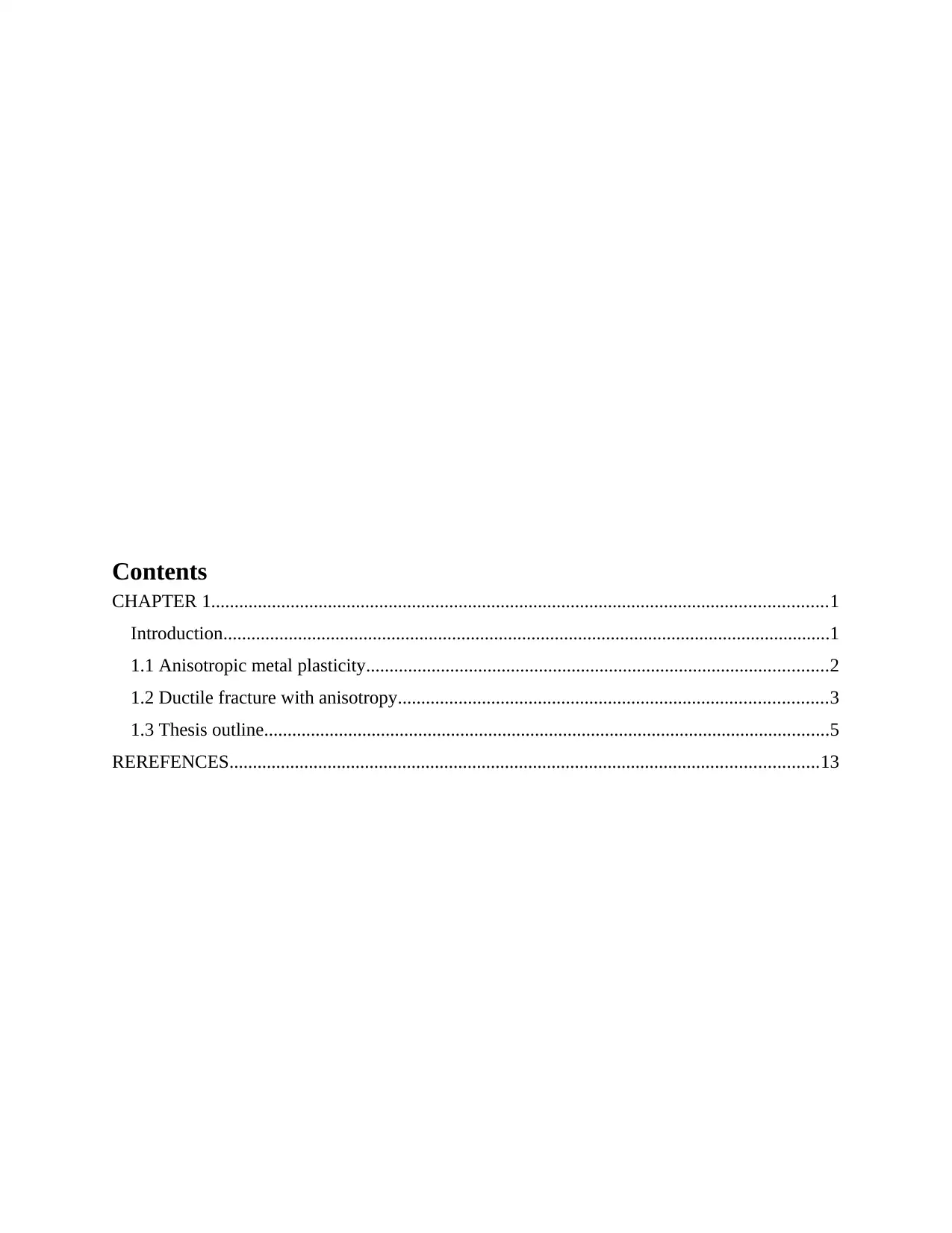
Contents
CHAPTER 1....................................................................................................................................1
Introduction..................................................................................................................................1
1.1 Anisotropic metal plasticity...................................................................................................2
1.2 Ductile fracture with anisotropy............................................................................................3
1.3 Thesis outline.........................................................................................................................5
REREFENCES..............................................................................................................................13
CHAPTER 1....................................................................................................................................1
Introduction..................................................................................................................................1
1.1 Anisotropic metal plasticity...................................................................................................2
1.2 Ductile fracture with anisotropy............................................................................................3
1.3 Thesis outline.........................................................................................................................5
REREFENCES..............................................................................................................................13
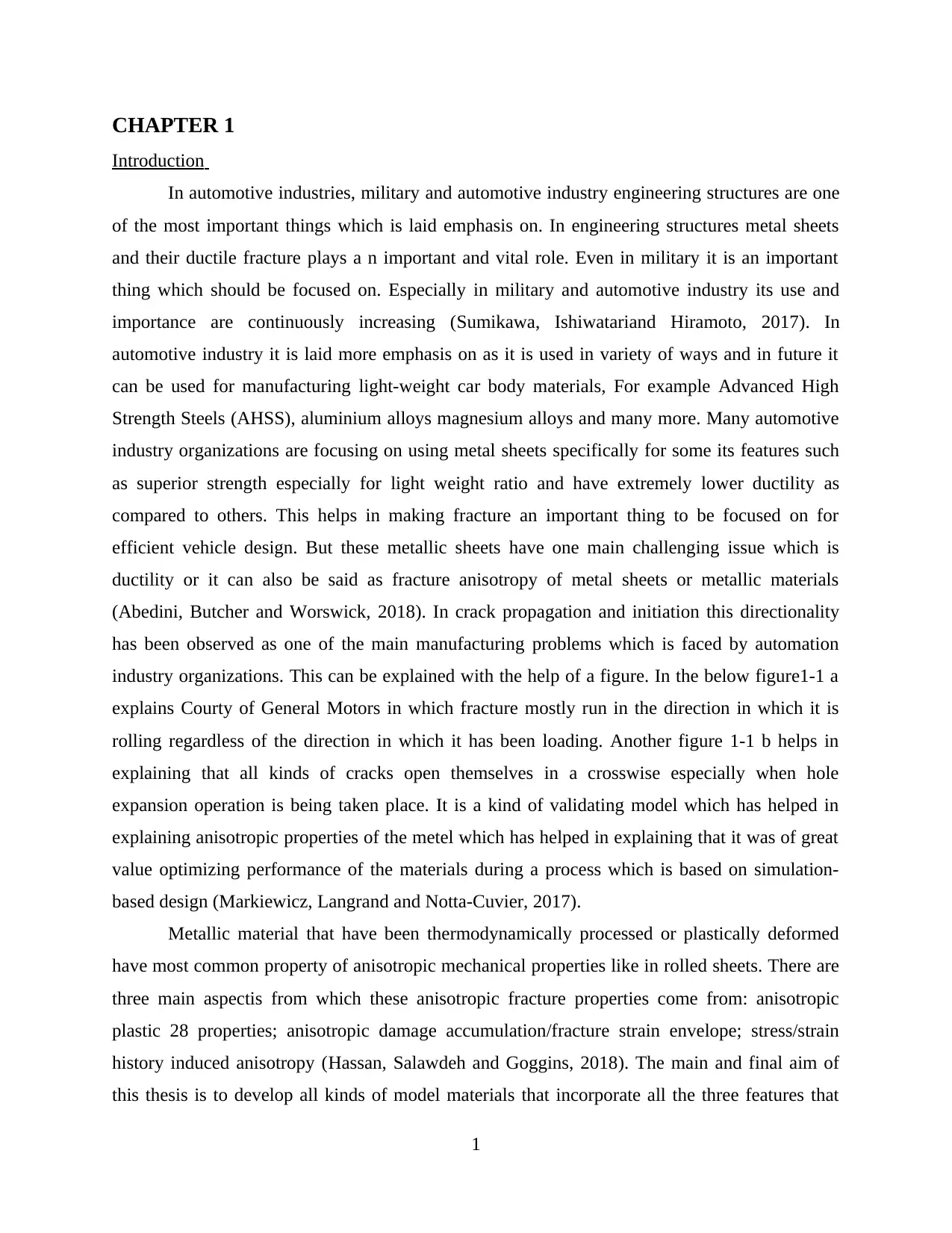
CHAPTER 1
Introduction
In automotive industries, military and automotive industry engineering structures are one
of the most important things which is laid emphasis on. In engineering structures metal sheets
and their ductile fracture plays a n important and vital role. Even in military it is an important
thing which should be focused on. Especially in military and automotive industry its use and
importance are continuously increasing (Sumikawa, Ishiwatariand Hiramoto, 2017). In
automotive industry it is laid more emphasis on as it is used in variety of ways and in future it
can be used for manufacturing light-weight car body materials, For example Advanced High
Strength Steels (AHSS), aluminium alloys magnesium alloys and many more. Many automotive
industry organizations are focusing on using metal sheets specifically for some its features such
as superior strength especially for light weight ratio and have extremely lower ductility as
compared to others. This helps in making fracture an important thing to be focused on for
efficient vehicle design. But these metallic sheets have one main challenging issue which is
ductility or it can also be said as fracture anisotropy of metal sheets or metallic materials
(Abedini, Butcher and Worswick, 2018). In crack propagation and initiation this directionality
has been observed as one of the main manufacturing problems which is faced by automation
industry organizations. This can be explained with the help of a figure. In the below figure1-1 a
explains Courty of General Motors in which fracture mostly run in the direction in which it is
rolling regardless of the direction in which it has been loading. Another figure 1-1 b helps in
explaining that all kinds of cracks open themselves in a crosswise especially when hole
expansion operation is being taken place. It is a kind of validating model which has helped in
explaining anisotropic properties of the metel which has helped in explaining that it was of great
value optimizing performance of the materials during a process which is based on simulation-
based design (Markiewicz, Langrand and Notta-Cuvier, 2017).
Metallic material that have been thermodynamically processed or plastically deformed
have most common property of anisotropic mechanical properties like in rolled sheets. There are
three main aspectis from which these anisotropic fracture properties come from: anisotropic
plastic 28 properties; anisotropic damage accumulation/fracture strain envelope; stress/strain
history induced anisotropy (Hassan, Salawdeh and Goggins, 2018). The main and final aim of
this thesis is to develop all kinds of model materials that incorporate all the three features that
1
Introduction
In automotive industries, military and automotive industry engineering structures are one
of the most important things which is laid emphasis on. In engineering structures metal sheets
and their ductile fracture plays a n important and vital role. Even in military it is an important
thing which should be focused on. Especially in military and automotive industry its use and
importance are continuously increasing (Sumikawa, Ishiwatariand Hiramoto, 2017). In
automotive industry it is laid more emphasis on as it is used in variety of ways and in future it
can be used for manufacturing light-weight car body materials, For example Advanced High
Strength Steels (AHSS), aluminium alloys magnesium alloys and many more. Many automotive
industry organizations are focusing on using metal sheets specifically for some its features such
as superior strength especially for light weight ratio and have extremely lower ductility as
compared to others. This helps in making fracture an important thing to be focused on for
efficient vehicle design. But these metallic sheets have one main challenging issue which is
ductility or it can also be said as fracture anisotropy of metal sheets or metallic materials
(Abedini, Butcher and Worswick, 2018). In crack propagation and initiation this directionality
has been observed as one of the main manufacturing problems which is faced by automation
industry organizations. This can be explained with the help of a figure. In the below figure1-1 a
explains Courty of General Motors in which fracture mostly run in the direction in which it is
rolling regardless of the direction in which it has been loading. Another figure 1-1 b helps in
explaining that all kinds of cracks open themselves in a crosswise especially when hole
expansion operation is being taken place. It is a kind of validating model which has helped in
explaining anisotropic properties of the metel which has helped in explaining that it was of great
value optimizing performance of the materials during a process which is based on simulation-
based design (Markiewicz, Langrand and Notta-Cuvier, 2017).
Metallic material that have been thermodynamically processed or plastically deformed
have most common property of anisotropic mechanical properties like in rolled sheets. There are
three main aspectis from which these anisotropic fracture properties come from: anisotropic
plastic 28 properties; anisotropic damage accumulation/fracture strain envelope; stress/strain
history induced anisotropy (Hassan, Salawdeh and Goggins, 2018). The main and final aim of
this thesis is to develop all kinds of model materials that incorporate all the three features that
1
⊘ This is a preview!⊘
Do you want full access?
Subscribe today to unlock all pages.

Trusted by 1+ million students worldwide
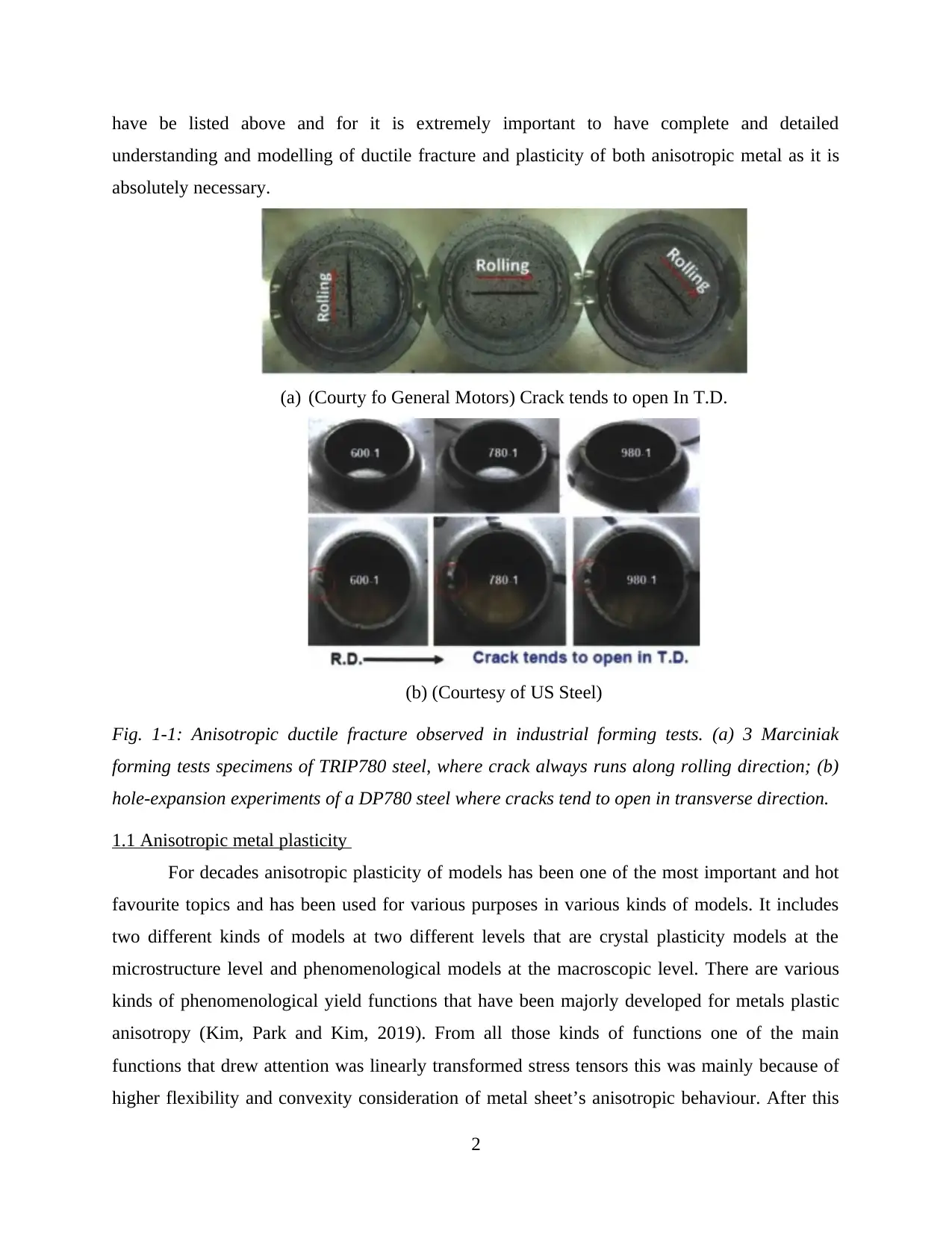
have be listed above and for it is extremely important to have complete and detailed
understanding and modelling of ductile fracture and plasticity of both anisotropic metal as it is
absolutely necessary.
(a) (Courty fo General Motors) Crack tends to open In T.D.
(b) (Courtesy of US Steel)
Fig. 1-1: Anisotropic ductile fracture observed in industrial forming tests. (a) 3 Marciniak
forming tests specimens of TRIP780 steel, where crack always runs along rolling direction; (b)
hole-expansion experiments of a DP780 steel where cracks tend to open in transverse direction.
1.1 Anisotropic metal plasticity
For decades anisotropic plasticity of models has been one of the most important and hot
favourite topics and has been used for various purposes in various kinds of models. It includes
two different kinds of models at two different levels that are crystal plasticity models at the
microstructure level and phenomenological models at the macroscopic level. There are various
kinds of phenomenological yield functions that have been majorly developed for metals plastic
anisotropy (Kim, Park and Kim, 2019). From all those kinds of functions one of the main
functions that drew attention was linearly transformed stress tensors this was mainly because of
higher flexibility and convexity consideration of metal sheet’s anisotropic behaviour. After this
2
understanding and modelling of ductile fracture and plasticity of both anisotropic metal as it is
absolutely necessary.
(a) (Courty fo General Motors) Crack tends to open In T.D.
(b) (Courtesy of US Steel)
Fig. 1-1: Anisotropic ductile fracture observed in industrial forming tests. (a) 3 Marciniak
forming tests specimens of TRIP780 steel, where crack always runs along rolling direction; (b)
hole-expansion experiments of a DP780 steel where cracks tend to open in transverse direction.
1.1 Anisotropic metal plasticity
For decades anisotropic plasticity of models has been one of the most important and hot
favourite topics and has been used for various purposes in various kinds of models. It includes
two different kinds of models at two different levels that are crystal plasticity models at the
microstructure level and phenomenological models at the macroscopic level. There are various
kinds of phenomenological yield functions that have been majorly developed for metals plastic
anisotropy (Kim, Park and Kim, 2019). From all those kinds of functions one of the main
functions that drew attention was linearly transformed stress tensors this was mainly because of
higher flexibility and convexity consideration of metal sheet’s anisotropic behaviour. After this
2
Paraphrase This Document
Need a fresh take? Get an instant paraphrase of this document with our AI Paraphraser
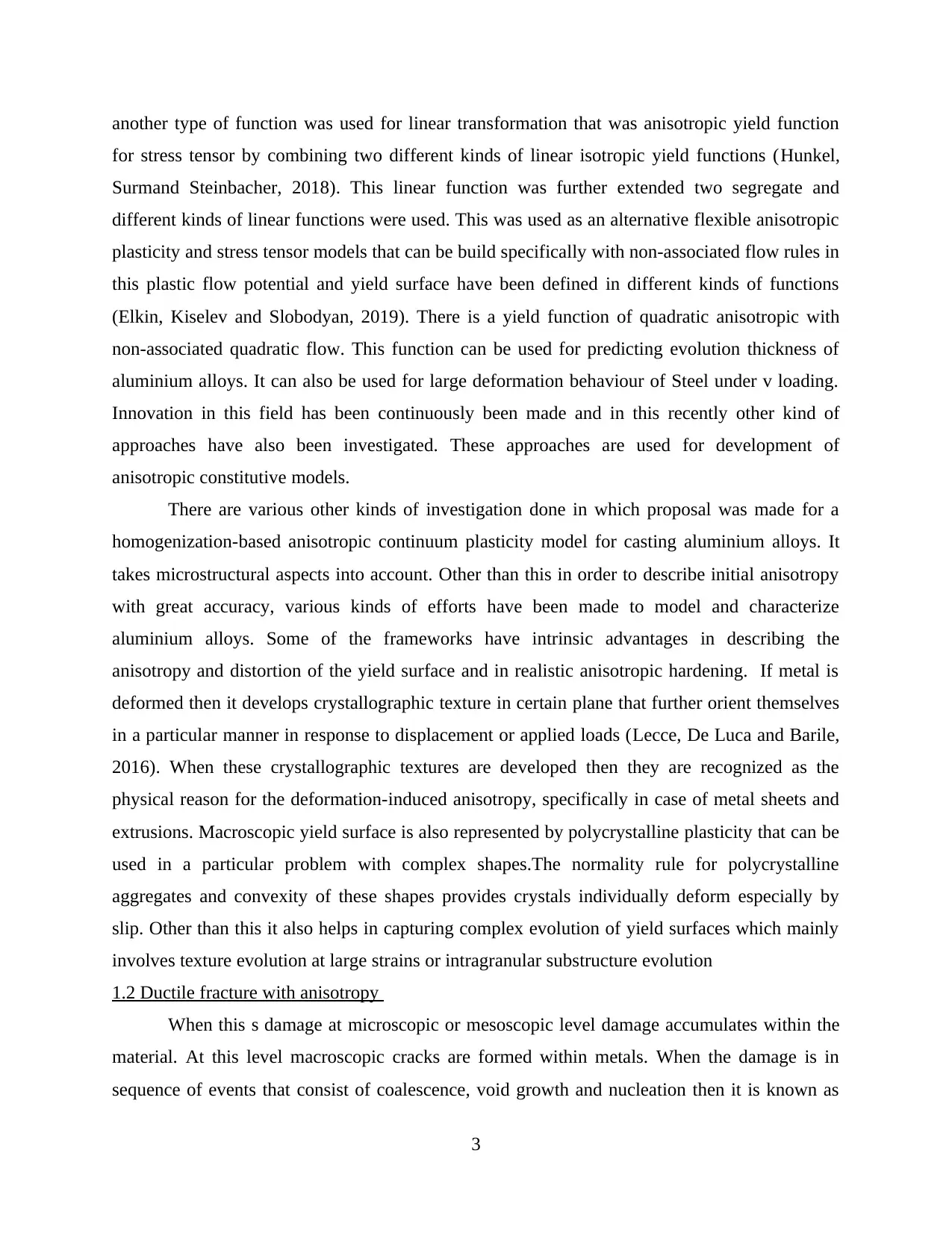
another type of function was used for linear transformation that was anisotropic yield function
for stress tensor by combining two different kinds of linear isotropic yield functions (Hunkel,
Surmand Steinbacher, 2018). This linear function was further extended two segregate and
different kinds of linear functions were used. This was used as an alternative flexible anisotropic
plasticity and stress tensor models that can be build specifically with non-associated flow rules in
this plastic flow potential and yield surface have been defined in different kinds of functions
(Elkin, Kiselev and Slobodyan, 2019). There is a yield function of quadratic anisotropic with
non-associated quadratic flow. This function can be used for predicting evolution thickness of
aluminium alloys. It can also be used for large deformation behaviour of Steel under v loading.
Innovation in this field has been continuously been made and in this recently other kind of
approaches have also been investigated. These approaches are used for development of
anisotropic constitutive models.
There are various other kinds of investigation done in which proposal was made for a
homogenization-based anisotropic continuum plasticity model for casting aluminium alloys. It
takes microstructural aspects into account. Other than this in order to describe initial anisotropy
with great accuracy, various kinds of efforts have been made to model and characterize
aluminium alloys. Some of the frameworks have intrinsic advantages in describing the
anisotropy and distortion of the yield surface and in realistic anisotropic hardening. If metal is
deformed then it develops crystallographic texture in certain plane that further orient themselves
in a particular manner in response to displacement or applied loads (Lecce, De Luca and Barile,
2016). When these crystallographic textures are developed then they are recognized as the
physical reason for the deformation-induced anisotropy, specifically in case of metal sheets and
extrusions. Macroscopic yield surface is also represented by polycrystalline plasticity that can be
used in a particular problem with complex shapes.The normality rule for polycrystalline
aggregates and convexity of these shapes provides crystals individually deform especially by
slip. Other than this it also helps in capturing complex evolution of yield surfaces which mainly
involves texture evolution at large strains or intragranular substructure evolution
1.2 Ductile fracture with anisotropy
When this s damage at microscopic or mesoscopic level damage accumulates within the
material. At this level macroscopic cracks are formed within metals. When the damage is in
sequence of events that consist of coalescence, void growth and nucleation then it is known as
3
for stress tensor by combining two different kinds of linear isotropic yield functions (Hunkel,
Surmand Steinbacher, 2018). This linear function was further extended two segregate and
different kinds of linear functions were used. This was used as an alternative flexible anisotropic
plasticity and stress tensor models that can be build specifically with non-associated flow rules in
this plastic flow potential and yield surface have been defined in different kinds of functions
(Elkin, Kiselev and Slobodyan, 2019). There is a yield function of quadratic anisotropic with
non-associated quadratic flow. This function can be used for predicting evolution thickness of
aluminium alloys. It can also be used for large deformation behaviour of Steel under v loading.
Innovation in this field has been continuously been made and in this recently other kind of
approaches have also been investigated. These approaches are used for development of
anisotropic constitutive models.
There are various other kinds of investigation done in which proposal was made for a
homogenization-based anisotropic continuum plasticity model for casting aluminium alloys. It
takes microstructural aspects into account. Other than this in order to describe initial anisotropy
with great accuracy, various kinds of efforts have been made to model and characterize
aluminium alloys. Some of the frameworks have intrinsic advantages in describing the
anisotropy and distortion of the yield surface and in realistic anisotropic hardening. If metal is
deformed then it develops crystallographic texture in certain plane that further orient themselves
in a particular manner in response to displacement or applied loads (Lecce, De Luca and Barile,
2016). When these crystallographic textures are developed then they are recognized as the
physical reason for the deformation-induced anisotropy, specifically in case of metal sheets and
extrusions. Macroscopic yield surface is also represented by polycrystalline plasticity that can be
used in a particular problem with complex shapes.The normality rule for polycrystalline
aggregates and convexity of these shapes provides crystals individually deform especially by
slip. Other than this it also helps in capturing complex evolution of yield surfaces which mainly
involves texture evolution at large strains or intragranular substructure evolution
1.2 Ductile fracture with anisotropy
When this s damage at microscopic or mesoscopic level damage accumulates within the
material. At this level macroscopic cracks are formed within metals. When the damage is in
sequence of events that consist of coalescence, void growth and nucleation then it is known as
3
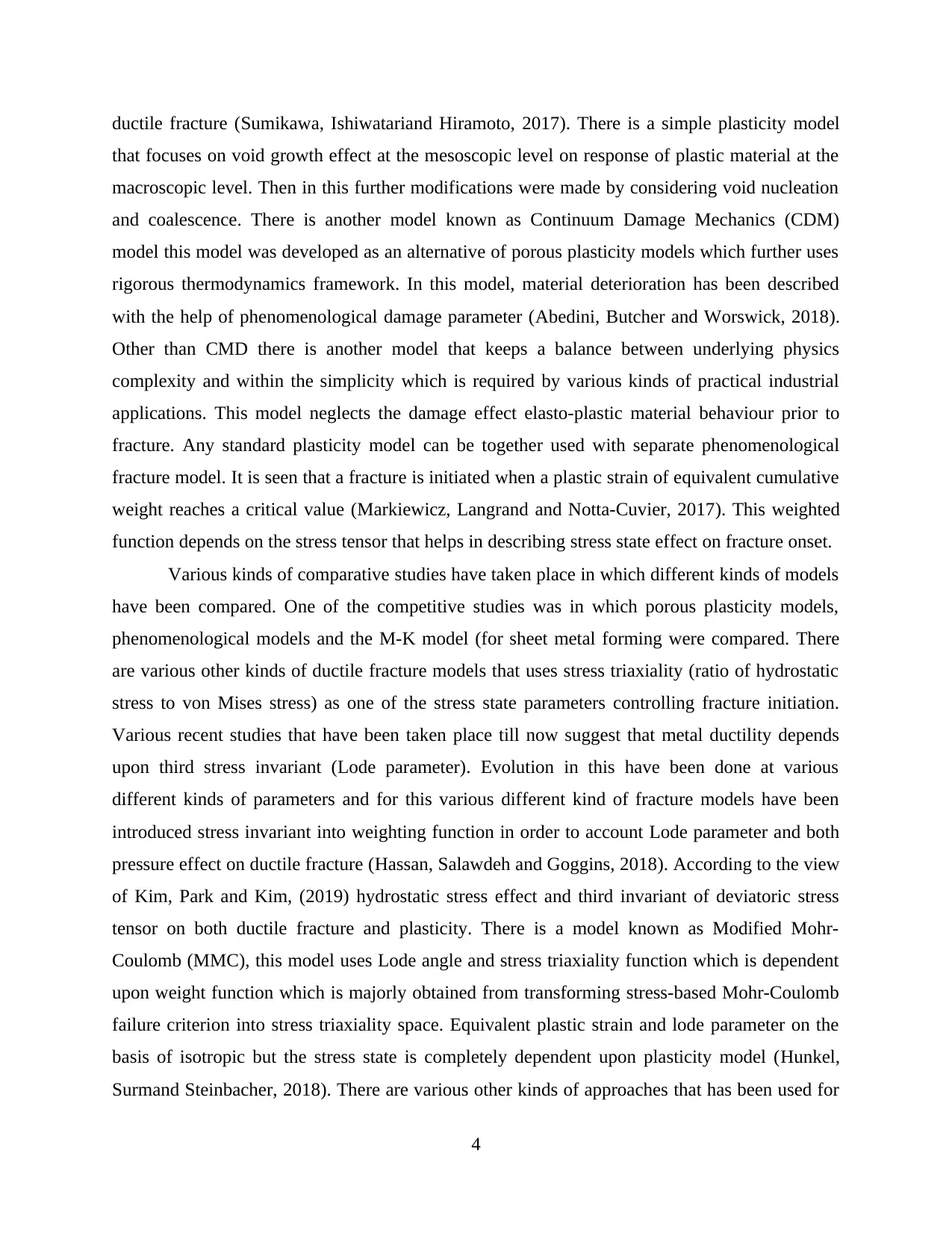
ductile fracture (Sumikawa, Ishiwatariand Hiramoto, 2017). There is a simple plasticity model
that focuses on void growth effect at the mesoscopic level on response of plastic material at the
macroscopic level. Then in this further modifications were made by considering void nucleation
and coalescence. There is another model known as Continuum Damage Mechanics (CDM)
model this model was developed as an alternative of porous plasticity models which further uses
rigorous thermodynamics framework. In this model, material deterioration has been described
with the help of phenomenological damage parameter (Abedini, Butcher and Worswick, 2018).
Other than CMD there is another model that keeps a balance between underlying physics
complexity and within the simplicity which is required by various kinds of practical industrial
applications. This model neglects the damage effect elasto-plastic material behaviour prior to
fracture. Any standard plasticity model can be together used with separate phenomenological
fracture model. It is seen that a fracture is initiated when a plastic strain of equivalent cumulative
weight reaches a critical value (Markiewicz, Langrand and Notta-Cuvier, 2017). This weighted
function depends on the stress tensor that helps in describing stress state effect on fracture onset.
Various kinds of comparative studies have taken place in which different kinds of models
have been compared. One of the competitive studies was in which porous plasticity models,
phenomenological models and the M-K model (for sheet metal forming were compared. There
are various other kinds of ductile fracture models that uses stress triaxiality (ratio of hydrostatic
stress to von Mises stress) as one of the stress state parameters controlling fracture initiation.
Various recent studies that have been taken place till now suggest that metal ductility depends
upon third stress invariant (Lode parameter). Evolution in this have been done at various
different kinds of parameters and for this various different kind of fracture models have been
introduced stress invariant into weighting function in order to account Lode parameter and both
pressure effect on ductile fracture (Hassan, Salawdeh and Goggins, 2018). According to the view
of Kim, Park and Kim, (2019) hydrostatic stress effect and third invariant of deviatoric stress
tensor on both ductile fracture and plasticity. There is a model known as Modified Mohr-
Coulomb (MMC), this model uses Lode angle and stress triaxiality function which is dependent
upon weight function which is majorly obtained from transforming stress-based Mohr-Coulomb
failure criterion into stress triaxiality space. Equivalent plastic strain and lode parameter on the
basis of isotropic but the stress state is completely dependent upon plasticity model (Hunkel,
Surmand Steinbacher, 2018). There are various other kinds of approaches that has been used for
4
that focuses on void growth effect at the mesoscopic level on response of plastic material at the
macroscopic level. Then in this further modifications were made by considering void nucleation
and coalescence. There is another model known as Continuum Damage Mechanics (CDM)
model this model was developed as an alternative of porous plasticity models which further uses
rigorous thermodynamics framework. In this model, material deterioration has been described
with the help of phenomenological damage parameter (Abedini, Butcher and Worswick, 2018).
Other than CMD there is another model that keeps a balance between underlying physics
complexity and within the simplicity which is required by various kinds of practical industrial
applications. This model neglects the damage effect elasto-plastic material behaviour prior to
fracture. Any standard plasticity model can be together used with separate phenomenological
fracture model. It is seen that a fracture is initiated when a plastic strain of equivalent cumulative
weight reaches a critical value (Markiewicz, Langrand and Notta-Cuvier, 2017). This weighted
function depends on the stress tensor that helps in describing stress state effect on fracture onset.
Various kinds of comparative studies have taken place in which different kinds of models
have been compared. One of the competitive studies was in which porous plasticity models,
phenomenological models and the M-K model (for sheet metal forming were compared. There
are various other kinds of ductile fracture models that uses stress triaxiality (ratio of hydrostatic
stress to von Mises stress) as one of the stress state parameters controlling fracture initiation.
Various recent studies that have been taken place till now suggest that metal ductility depends
upon third stress invariant (Lode parameter). Evolution in this have been done at various
different kinds of parameters and for this various different kind of fracture models have been
introduced stress invariant into weighting function in order to account Lode parameter and both
pressure effect on ductile fracture (Hassan, Salawdeh and Goggins, 2018). According to the view
of Kim, Park and Kim, (2019) hydrostatic stress effect and third invariant of deviatoric stress
tensor on both ductile fracture and plasticity. There is a model known as Modified Mohr-
Coulomb (MMC), this model uses Lode angle and stress triaxiality function which is dependent
upon weight function which is majorly obtained from transforming stress-based Mohr-Coulomb
failure criterion into stress triaxiality space. Equivalent plastic strain and lode parameter on the
basis of isotropic but the stress state is completely dependent upon plasticity model (Hunkel,
Surmand Steinbacher, 2018). There are various other kinds of approaches that has been used for
4
⊘ This is a preview!⊘
Do you want full access?
Subscribe today to unlock all pages.

Trusted by 1+ million students worldwide
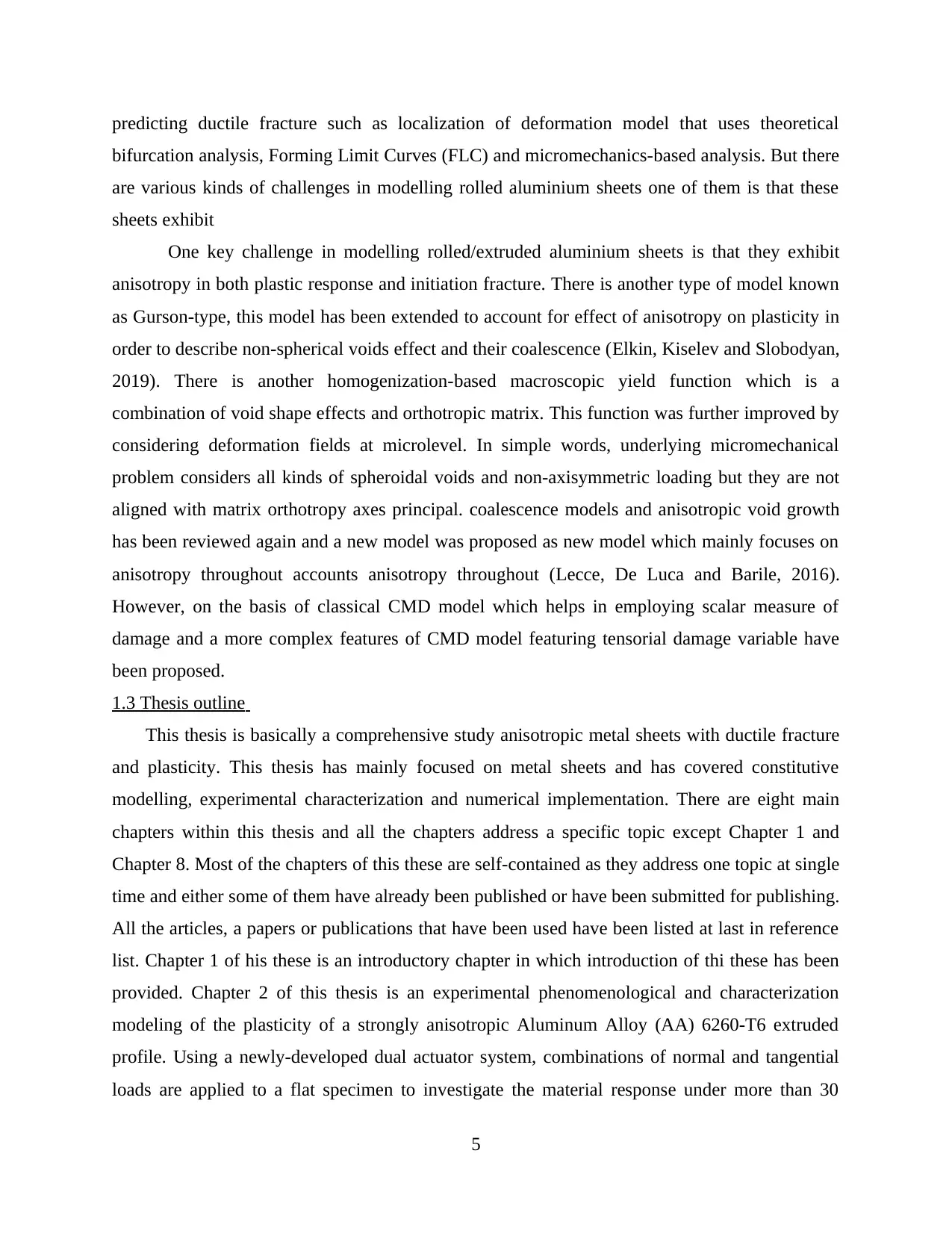
predicting ductile fracture such as localization of deformation model that uses theoretical
bifurcation analysis, Forming Limit Curves (FLC) and micromechanics-based analysis. But there
are various kinds of challenges in modelling rolled aluminium sheets one of them is that these
sheets exhibit
One key challenge in modelling rolled/extruded aluminium sheets is that they exhibit
anisotropy in both plastic response and initiation fracture. There is another type of model known
as Gurson-type, this model has been extended to account for effect of anisotropy on plasticity in
order to describe non-spherical voids effect and their coalescence (Elkin, Kiselev and Slobodyan,
2019). There is another homogenization-based macroscopic yield function which is a
combination of void shape effects and orthotropic matrix. This function was further improved by
considering deformation fields at microlevel. In simple words, underlying micromechanical
problem considers all kinds of spheroidal voids and non-axisymmetric loading but they are not
aligned with matrix orthotropy axes principal. coalescence models and anisotropic void growth
has been reviewed again and a new model was proposed as new model which mainly focuses on
anisotropy throughout accounts anisotropy throughout (Lecce, De Luca and Barile, 2016).
However, on the basis of classical CMD model which helps in employing scalar measure of
damage and a more complex features of CMD model featuring tensorial damage variable have
been proposed.
1.3 Thesis outline
This thesis is basically a comprehensive study anisotropic metal sheets with ductile fracture
and plasticity. This thesis has mainly focused on metal sheets and has covered constitutive
modelling, experimental characterization and numerical implementation. There are eight main
chapters within this thesis and all the chapters address a specific topic except Chapter 1 and
Chapter 8. Most of the chapters of this these are self-contained as they address one topic at single
time and either some of them have already been published or have been submitted for publishing.
All the articles, a papers or publications that have been used have been listed at last in reference
list. Chapter 1 of his these is an introductory chapter in which introduction of thi these has been
provided. Chapter 2 of this thesis is an experimental phenomenological and characterization
modeling of the plasticity of a strongly anisotropic Aluminum Alloy (AA) 6260-T6 extruded
profile. Using a newly-developed dual actuator system, combinations of normal and tangential
loads are applied to a flat specimen to investigate the material response under more than 30
5
bifurcation analysis, Forming Limit Curves (FLC) and micromechanics-based analysis. But there
are various kinds of challenges in modelling rolled aluminium sheets one of them is that these
sheets exhibit
One key challenge in modelling rolled/extruded aluminium sheets is that they exhibit
anisotropy in both plastic response and initiation fracture. There is another type of model known
as Gurson-type, this model has been extended to account for effect of anisotropy on plasticity in
order to describe non-spherical voids effect and their coalescence (Elkin, Kiselev and Slobodyan,
2019). There is another homogenization-based macroscopic yield function which is a
combination of void shape effects and orthotropic matrix. This function was further improved by
considering deformation fields at microlevel. In simple words, underlying micromechanical
problem considers all kinds of spheroidal voids and non-axisymmetric loading but they are not
aligned with matrix orthotropy axes principal. coalescence models and anisotropic void growth
has been reviewed again and a new model was proposed as new model which mainly focuses on
anisotropy throughout accounts anisotropy throughout (Lecce, De Luca and Barile, 2016).
However, on the basis of classical CMD model which helps in employing scalar measure of
damage and a more complex features of CMD model featuring tensorial damage variable have
been proposed.
1.3 Thesis outline
This thesis is basically a comprehensive study anisotropic metal sheets with ductile fracture
and plasticity. This thesis has mainly focused on metal sheets and has covered constitutive
modelling, experimental characterization and numerical implementation. There are eight main
chapters within this thesis and all the chapters address a specific topic except Chapter 1 and
Chapter 8. Most of the chapters of this these are self-contained as they address one topic at single
time and either some of them have already been published or have been submitted for publishing.
All the articles, a papers or publications that have been used have been listed at last in reference
list. Chapter 1 of his these is an introductory chapter in which introduction of thi these has been
provided. Chapter 2 of this thesis is an experimental phenomenological and characterization
modeling of the plasticity of a strongly anisotropic Aluminum Alloy (AA) 6260-T6 extruded
profile. Using a newly-developed dual actuator system, combinations of normal and tangential
loads are applied to a flat specimen to investigate the material response under more than 30
5
Paraphrase This Document
Need a fresh take? Get an instant paraphrase of this document with our AI Paraphraser
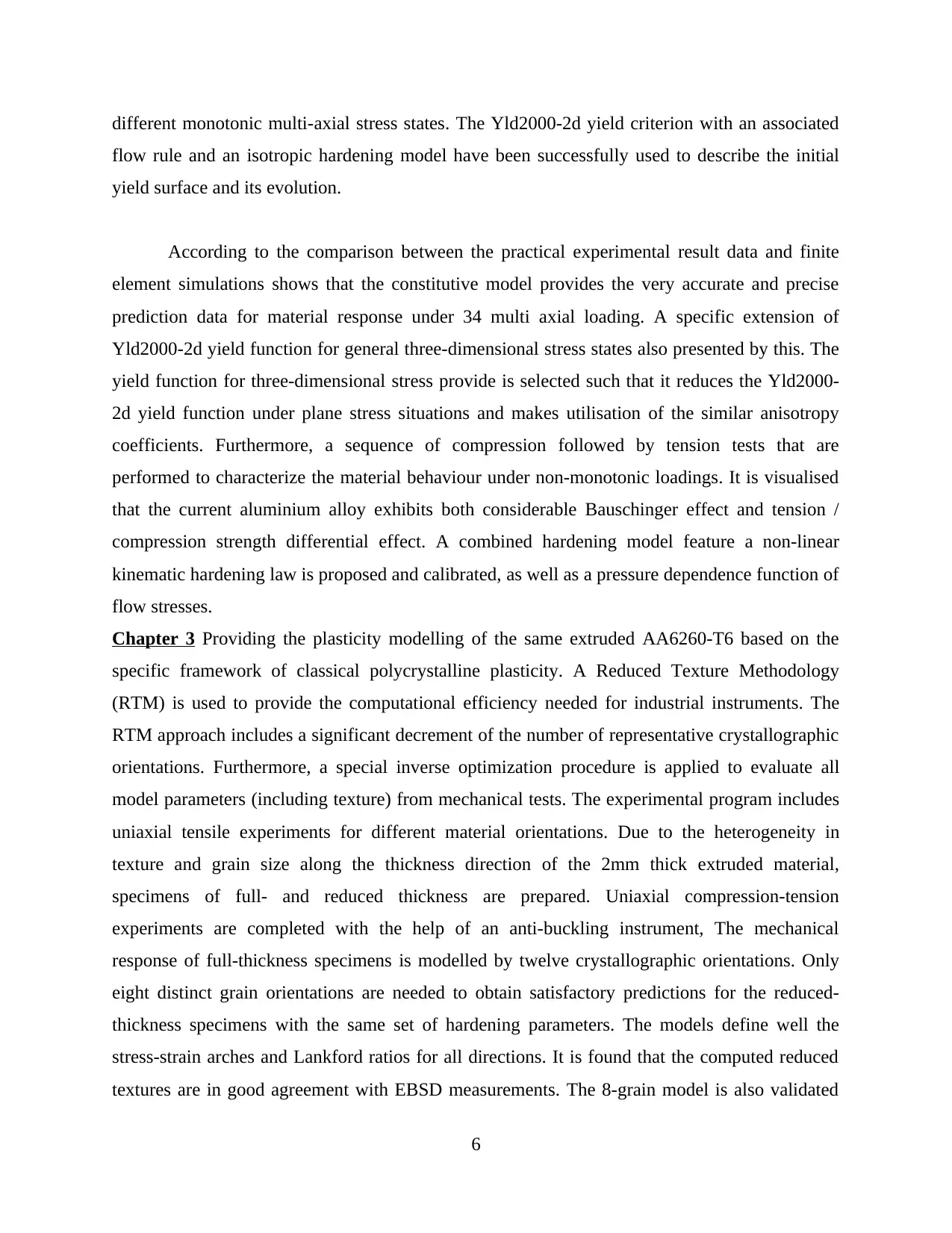
different monotonic multi-axial stress states. The Yld2000-2d yield criterion with an associated
flow rule and an isotropic hardening model have been successfully used to describe the initial
yield surface and its evolution.
According to the comparison between the practical experimental result data and finite
element simulations shows that the constitutive model provides the very accurate and precise
prediction data for material response under 34 multi axial loading. A specific extension of
Yld2000-2d yield function for general three-dimensional stress states also presented by this. The
yield function for three-dimensional stress provide is selected such that it reduces the Yld2000-
2d yield function under plane stress situations and makes utilisation of the similar anisotropy
coefficients. Furthermore, a sequence of compression followed by tension tests that are
performed to characterize the material behaviour under non-monotonic loadings. It is visualised
that the current aluminium alloy exhibits both considerable Bauschinger effect and tension /
compression strength differential effect. A combined hardening model feature a non-linear
kinematic hardening law is proposed and calibrated, as well as a pressure dependence function of
flow stresses.
Chapter 3 Providing the plasticity modelling of the same extruded AA6260-T6 based on the
specific framework of classical polycrystalline plasticity. A Reduced Texture Methodology
(RTM) is used to provide the computational efficiency needed for industrial instruments. The
RTM approach includes a significant decrement of the number of representative crystallographic
orientations. Furthermore, a special inverse optimization procedure is applied to evaluate all
model parameters (including texture) from mechanical tests. The experimental program includes
uniaxial tensile experiments for different material orientations. Due to the heterogeneity in
texture and grain size along the thickness direction of the 2mm thick extruded material,
specimens of full- and reduced thickness are prepared. Uniaxial compression-tension
experiments are completed with the help of an anti-buckling instrument, The mechanical
response of full-thickness specimens is modelled by twelve crystallographic orientations. Only
eight distinct grain orientations are needed to obtain satisfactory predictions for the reduced-
thickness specimens with the same set of hardening parameters. The models define well the
stress-strain arches and Lankford ratios for all directions. It is found that the computed reduced
textures are in good agreement with EBSD measurements. The 8-grain model is also validated
6
flow rule and an isotropic hardening model have been successfully used to describe the initial
yield surface and its evolution.
According to the comparison between the practical experimental result data and finite
element simulations shows that the constitutive model provides the very accurate and precise
prediction data for material response under 34 multi axial loading. A specific extension of
Yld2000-2d yield function for general three-dimensional stress states also presented by this. The
yield function for three-dimensional stress provide is selected such that it reduces the Yld2000-
2d yield function under plane stress situations and makes utilisation of the similar anisotropy
coefficients. Furthermore, a sequence of compression followed by tension tests that are
performed to characterize the material behaviour under non-monotonic loadings. It is visualised
that the current aluminium alloy exhibits both considerable Bauschinger effect and tension /
compression strength differential effect. A combined hardening model feature a non-linear
kinematic hardening law is proposed and calibrated, as well as a pressure dependence function of
flow stresses.
Chapter 3 Providing the plasticity modelling of the same extruded AA6260-T6 based on the
specific framework of classical polycrystalline plasticity. A Reduced Texture Methodology
(RTM) is used to provide the computational efficiency needed for industrial instruments. The
RTM approach includes a significant decrement of the number of representative crystallographic
orientations. Furthermore, a special inverse optimization procedure is applied to evaluate all
model parameters (including texture) from mechanical tests. The experimental program includes
uniaxial tensile experiments for different material orientations. Due to the heterogeneity in
texture and grain size along the thickness direction of the 2mm thick extruded material,
specimens of full- and reduced thickness are prepared. Uniaxial compression-tension
experiments are completed with the help of an anti-buckling instrument, The mechanical
response of full-thickness specimens is modelled by twelve crystallographic orientations. Only
eight distinct grain orientations are needed to obtain satisfactory predictions for the reduced-
thickness specimens with the same set of hardening parameters. The models define well the
stress-strain arches and Lankford ratios for all directions. It is found that the computed reduced
textures are in good agreement with EBSD measurements. The 8-grain model is also validated
6
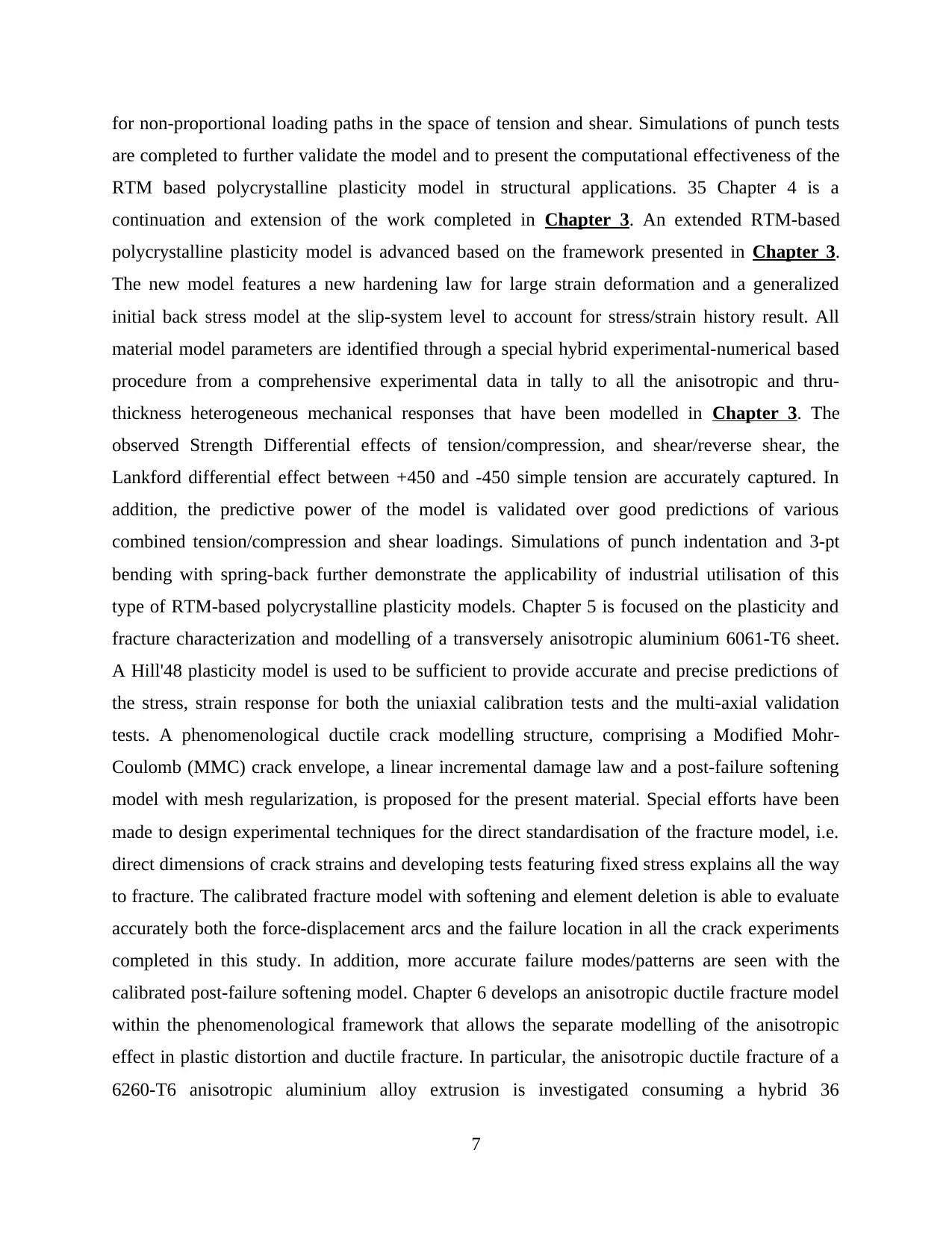
for non-proportional loading paths in the space of tension and shear. Simulations of punch tests
are completed to further validate the model and to present the computational effectiveness of the
RTM based polycrystalline plasticity model in structural applications. 35 Chapter 4 is a
continuation and extension of the work completed in Chapter 3. An extended RTM-based
polycrystalline plasticity model is advanced based on the framework presented in Chapter 3.
The new model features a new hardening law for large strain deformation and a generalized
initial back stress model at the slip-system level to account for stress/strain history result. All
material model parameters are identified through a special hybrid experimental-numerical based
procedure from a comprehensive experimental data in tally to all the anisotropic and thru-
thickness heterogeneous mechanical responses that have been modelled in Chapter 3. The
observed Strength Differential effects of tension/compression, and shear/reverse shear, the
Lankford differential effect between +450 and -450 simple tension are accurately captured. In
addition, the predictive power of the model is validated over good predictions of various
combined tension/compression and shear loadings. Simulations of punch indentation and 3-pt
bending with spring-back further demonstrate the applicability of industrial utilisation of this
type of RTM-based polycrystalline plasticity models. Chapter 5 is focused on the plasticity and
fracture characterization and modelling of a transversely anisotropic aluminium 6061-T6 sheet.
A Hill'48 plasticity model is used to be sufficient to provide accurate and precise predictions of
the stress, strain response for both the uniaxial calibration tests and the multi-axial validation
tests. A phenomenological ductile crack modelling structure, comprising a Modified Mohr-
Coulomb (MMC) crack envelope, a linear incremental damage law and a post-failure softening
model with mesh regularization, is proposed for the present material. Special efforts have been
made to design experimental techniques for the direct standardisation of the fracture model, i.e.
direct dimensions of crack strains and developing tests featuring fixed stress explains all the way
to fracture. The calibrated fracture model with softening and element deletion is able to evaluate
accurately both the force-displacement arcs and the failure location in all the crack experiments
completed in this study. In addition, more accurate failure modes/patterns are seen with the
calibrated post-failure softening model. Chapter 6 develops an anisotropic ductile fracture model
within the phenomenological framework that allows the separate modelling of the anisotropic
effect in plastic distortion and ductile fracture. In particular, the anisotropic ductile fracture of a
6260-T6 anisotropic aluminium alloy extrusion is investigated consuming a hybrid 36
7
are completed to further validate the model and to present the computational effectiveness of the
RTM based polycrystalline plasticity model in structural applications. 35 Chapter 4 is a
continuation and extension of the work completed in Chapter 3. An extended RTM-based
polycrystalline plasticity model is advanced based on the framework presented in Chapter 3.
The new model features a new hardening law for large strain deformation and a generalized
initial back stress model at the slip-system level to account for stress/strain history result. All
material model parameters are identified through a special hybrid experimental-numerical based
procedure from a comprehensive experimental data in tally to all the anisotropic and thru-
thickness heterogeneous mechanical responses that have been modelled in Chapter 3. The
observed Strength Differential effects of tension/compression, and shear/reverse shear, the
Lankford differential effect between +450 and -450 simple tension are accurately captured. In
addition, the predictive power of the model is validated over good predictions of various
combined tension/compression and shear loadings. Simulations of punch indentation and 3-pt
bending with spring-back further demonstrate the applicability of industrial utilisation of this
type of RTM-based polycrystalline plasticity models. Chapter 5 is focused on the plasticity and
fracture characterization and modelling of a transversely anisotropic aluminium 6061-T6 sheet.
A Hill'48 plasticity model is used to be sufficient to provide accurate and precise predictions of
the stress, strain response for both the uniaxial calibration tests and the multi-axial validation
tests. A phenomenological ductile crack modelling structure, comprising a Modified Mohr-
Coulomb (MMC) crack envelope, a linear incremental damage law and a post-failure softening
model with mesh regularization, is proposed for the present material. Special efforts have been
made to design experimental techniques for the direct standardisation of the fracture model, i.e.
direct dimensions of crack strains and developing tests featuring fixed stress explains all the way
to fracture. The calibrated fracture model with softening and element deletion is able to evaluate
accurately both the force-displacement arcs and the failure location in all the crack experiments
completed in this study. In addition, more accurate failure modes/patterns are seen with the
calibrated post-failure softening model. Chapter 6 develops an anisotropic ductile fracture model
within the phenomenological framework that allows the separate modelling of the anisotropic
effect in plastic distortion and ductile fracture. In particular, the anisotropic ductile fracture of a
6260-T6 anisotropic aluminium alloy extrusion is investigated consuming a hybrid 36
7
⊘ This is a preview!⊘
Do you want full access?
Subscribe today to unlock all pages.

Trusted by 1+ million students worldwide
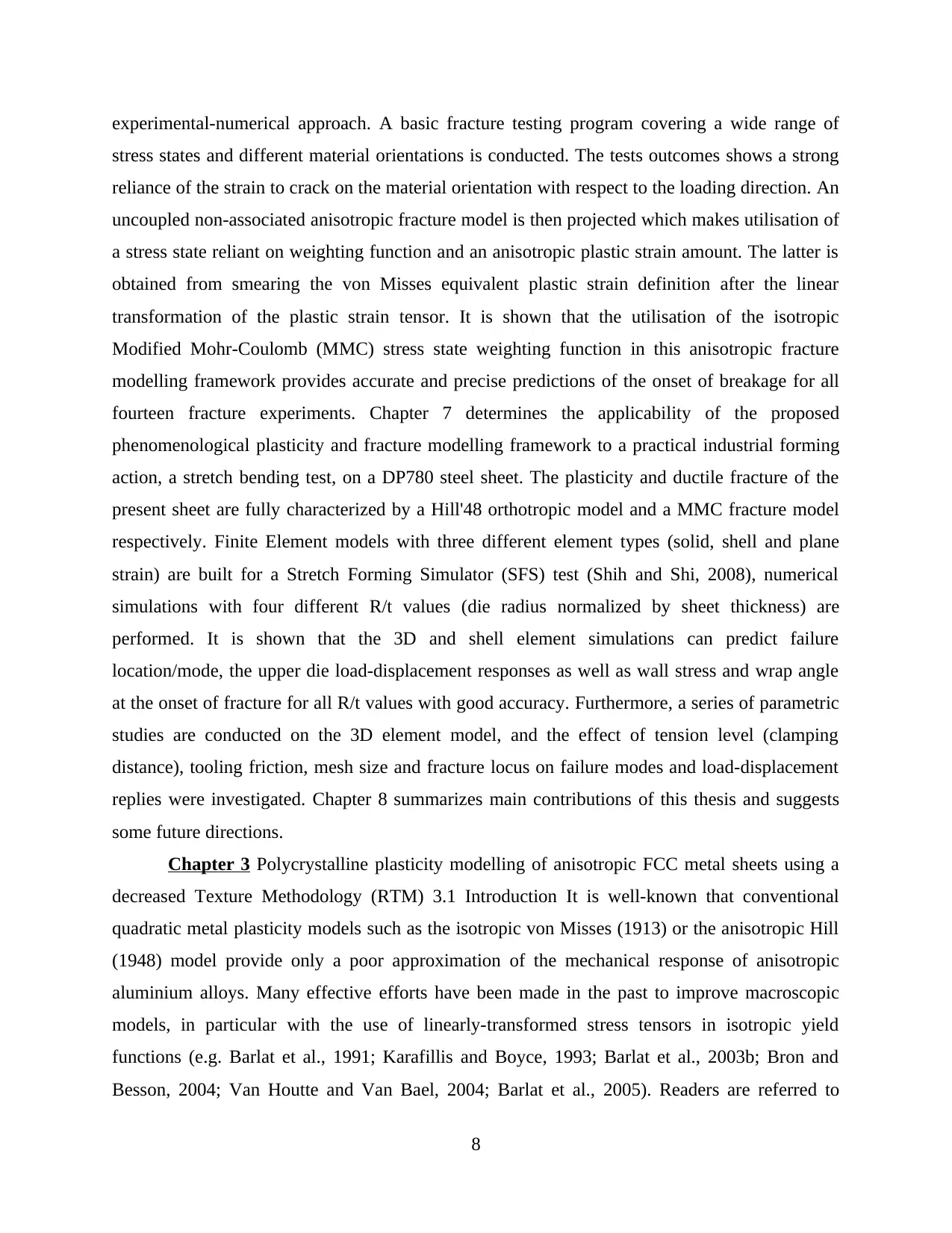
experimental-numerical approach. A basic fracture testing program covering a wide range of
stress states and different material orientations is conducted. The tests outcomes shows a strong
reliance of the strain to crack on the material orientation with respect to the loading direction. An
uncoupled non-associated anisotropic fracture model is then projected which makes utilisation of
a stress state reliant on weighting function and an anisotropic plastic strain amount. The latter is
obtained from smearing the von Misses equivalent plastic strain definition after the linear
transformation of the plastic strain tensor. It is shown that the utilisation of the isotropic
Modified Mohr-Coulomb (MMC) stress state weighting function in this anisotropic fracture
modelling framework provides accurate and precise predictions of the onset of breakage for all
fourteen fracture experiments. Chapter 7 determines the applicability of the proposed
phenomenological plasticity and fracture modelling framework to a practical industrial forming
action, a stretch bending test, on a DP780 steel sheet. The plasticity and ductile fracture of the
present sheet are fully characterized by a Hill'48 orthotropic model and a MMC fracture model
respectively. Finite Element models with three different element types (solid, shell and plane
strain) are built for a Stretch Forming Simulator (SFS) test (Shih and Shi, 2008), numerical
simulations with four different R/t values (die radius normalized by sheet thickness) are
performed. It is shown that the 3D and shell element simulations can predict failure
location/mode, the upper die load-displacement responses as well as wall stress and wrap angle
at the onset of fracture for all R/t values with good accuracy. Furthermore, a series of parametric
studies are conducted on the 3D element model, and the effect of tension level (clamping
distance), tooling friction, mesh size and fracture locus on failure modes and load-displacement
replies were investigated. Chapter 8 summarizes main contributions of this thesis and suggests
some future directions.
Chapter 3 Polycrystalline plasticity modelling of anisotropic FCC metal sheets using a
decreased Texture Methodology (RTM) 3.1 Introduction It is well-known that conventional
quadratic metal plasticity models such as the isotropic von Misses (1913) or the anisotropic Hill
(1948) model provide only a poor approximation of the mechanical response of anisotropic
aluminium alloys. Many effective efforts have been made in the past to improve macroscopic
models, in particular with the use of linearly-transformed stress tensors in isotropic yield
functions (e.g. Barlat et al., 1991; Karafillis and Boyce, 1993; Barlat et al., 2003b; Bron and
Besson, 2004; Van Houtte and Van Bael, 2004; Barlat et al., 2005). Readers are referred to
8
stress states and different material orientations is conducted. The tests outcomes shows a strong
reliance of the strain to crack on the material orientation with respect to the loading direction. An
uncoupled non-associated anisotropic fracture model is then projected which makes utilisation of
a stress state reliant on weighting function and an anisotropic plastic strain amount. The latter is
obtained from smearing the von Misses equivalent plastic strain definition after the linear
transformation of the plastic strain tensor. It is shown that the utilisation of the isotropic
Modified Mohr-Coulomb (MMC) stress state weighting function in this anisotropic fracture
modelling framework provides accurate and precise predictions of the onset of breakage for all
fourteen fracture experiments. Chapter 7 determines the applicability of the proposed
phenomenological plasticity and fracture modelling framework to a practical industrial forming
action, a stretch bending test, on a DP780 steel sheet. The plasticity and ductile fracture of the
present sheet are fully characterized by a Hill'48 orthotropic model and a MMC fracture model
respectively. Finite Element models with three different element types (solid, shell and plane
strain) are built for a Stretch Forming Simulator (SFS) test (Shih and Shi, 2008), numerical
simulations with four different R/t values (die radius normalized by sheet thickness) are
performed. It is shown that the 3D and shell element simulations can predict failure
location/mode, the upper die load-displacement responses as well as wall stress and wrap angle
at the onset of fracture for all R/t values with good accuracy. Furthermore, a series of parametric
studies are conducted on the 3D element model, and the effect of tension level (clamping
distance), tooling friction, mesh size and fracture locus on failure modes and load-displacement
replies were investigated. Chapter 8 summarizes main contributions of this thesis and suggests
some future directions.
Chapter 3 Polycrystalline plasticity modelling of anisotropic FCC metal sheets using a
decreased Texture Methodology (RTM) 3.1 Introduction It is well-known that conventional
quadratic metal plasticity models such as the isotropic von Misses (1913) or the anisotropic Hill
(1948) model provide only a poor approximation of the mechanical response of anisotropic
aluminium alloys. Many effective efforts have been made in the past to improve macroscopic
models, in particular with the use of linearly-transformed stress tensors in isotropic yield
functions (e.g. Barlat et al., 1991; Karafillis and Boyce, 1993; Barlat et al., 2003b; Bron and
Besson, 2004; Van Houtte and Van Bael, 2004; Barlat et al., 2005). Readers are referred to
8
Paraphrase This Document
Need a fresh take? Get an instant paraphrase of this document with our AI Paraphraser
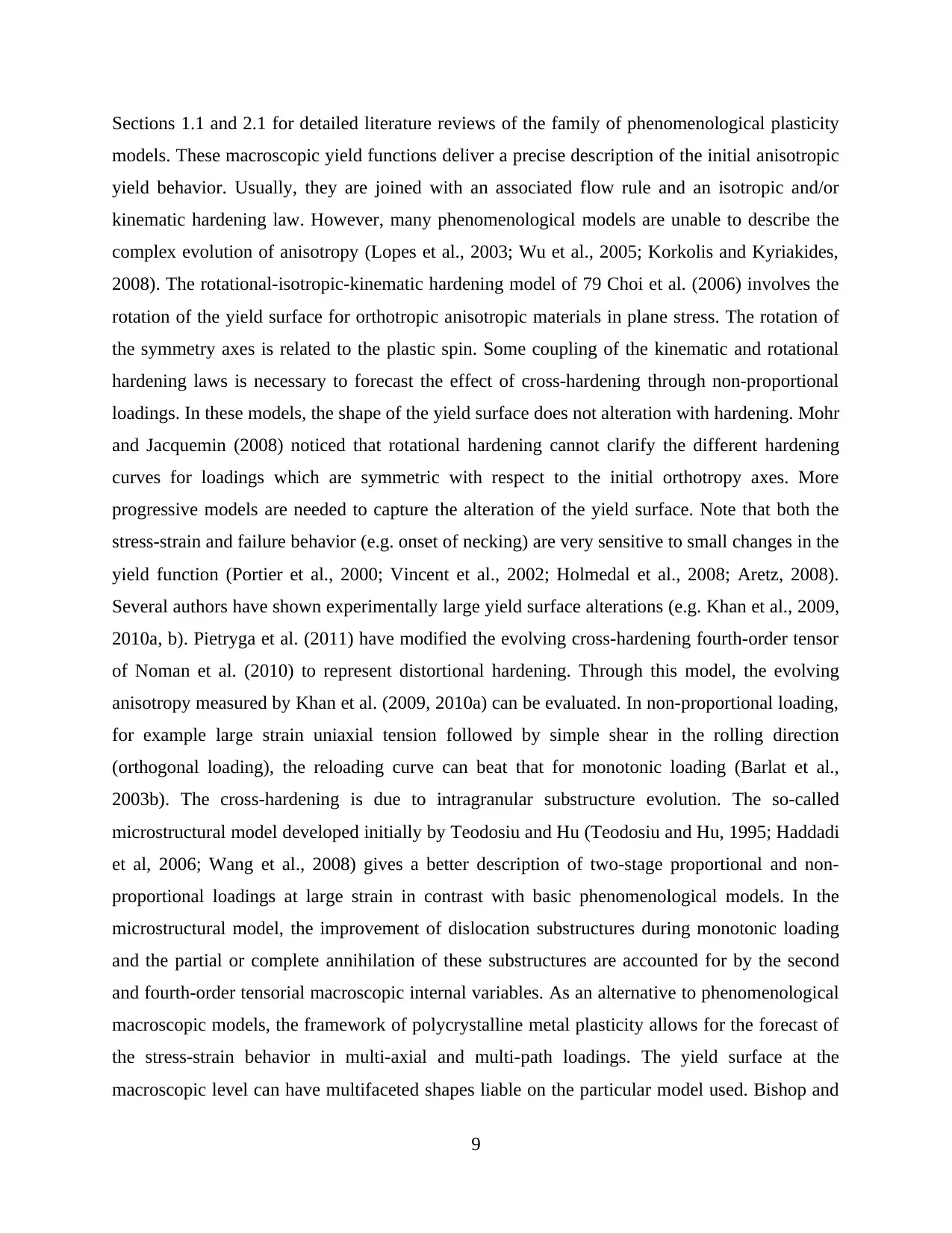
Sections 1.1 and 2.1 for detailed literature reviews of the family of phenomenological plasticity
models. These macroscopic yield functions deliver a precise description of the initial anisotropic
yield behavior. Usually, they are joined with an associated flow rule and an isotropic and/or
kinematic hardening law. However, many phenomenological models are unable to describe the
complex evolution of anisotropy (Lopes et al., 2003; Wu et al., 2005; Korkolis and Kyriakides,
2008). The rotational-isotropic-kinematic hardening model of 79 Choi et al. (2006) involves the
rotation of the yield surface for orthotropic anisotropic materials in plane stress. The rotation of
the symmetry axes is related to the plastic spin. Some coupling of the kinematic and rotational
hardening laws is necessary to forecast the effect of cross-hardening through non-proportional
loadings. In these models, the shape of the yield surface does not alteration with hardening. Mohr
and Jacquemin (2008) noticed that rotational hardening cannot clarify the different hardening
curves for loadings which are symmetric with respect to the initial orthotropy axes. More
progressive models are needed to capture the alteration of the yield surface. Note that both the
stress-strain and failure behavior (e.g. onset of necking) are very sensitive to small changes in the
yield function (Portier et al., 2000; Vincent et al., 2002; Holmedal et al., 2008; Aretz, 2008).
Several authors have shown experimentally large yield surface alterations (e.g. Khan et al., 2009,
2010a, b). Pietryga et al. (2011) have modified the evolving cross-hardening fourth-order tensor
of Noman et al. (2010) to represent distortional hardening. Through this model, the evolving
anisotropy measured by Khan et al. (2009, 2010a) can be evaluated. In non-proportional loading,
for example large strain uniaxial tension followed by simple shear in the rolling direction
(orthogonal loading), the reloading curve can beat that for monotonic loading (Barlat et al.,
2003b). The cross-hardening is due to intragranular substructure evolution. The so-called
microstructural model developed initially by Teodosiu and Hu (Teodosiu and Hu, 1995; Haddadi
et al, 2006; Wang et al., 2008) gives a better description of two-stage proportional and non-
proportional loadings at large strain in contrast with basic phenomenological models. In the
microstructural model, the improvement of dislocation substructures during monotonic loading
and the partial or complete annihilation of these substructures are accounted for by the second
and fourth-order tensorial macroscopic internal variables. As an alternative to phenomenological
macroscopic models, the framework of polycrystalline metal plasticity allows for the forecast of
the stress-strain behavior in multi-axial and multi-path loadings. The yield surface at the
macroscopic level can have multifaceted shapes liable on the particular model used. Bishop and
9
models. These macroscopic yield functions deliver a precise description of the initial anisotropic
yield behavior. Usually, they are joined with an associated flow rule and an isotropic and/or
kinematic hardening law. However, many phenomenological models are unable to describe the
complex evolution of anisotropy (Lopes et al., 2003; Wu et al., 2005; Korkolis and Kyriakides,
2008). The rotational-isotropic-kinematic hardening model of 79 Choi et al. (2006) involves the
rotation of the yield surface for orthotropic anisotropic materials in plane stress. The rotation of
the symmetry axes is related to the plastic spin. Some coupling of the kinematic and rotational
hardening laws is necessary to forecast the effect of cross-hardening through non-proportional
loadings. In these models, the shape of the yield surface does not alteration with hardening. Mohr
and Jacquemin (2008) noticed that rotational hardening cannot clarify the different hardening
curves for loadings which are symmetric with respect to the initial orthotropy axes. More
progressive models are needed to capture the alteration of the yield surface. Note that both the
stress-strain and failure behavior (e.g. onset of necking) are very sensitive to small changes in the
yield function (Portier et al., 2000; Vincent et al., 2002; Holmedal et al., 2008; Aretz, 2008).
Several authors have shown experimentally large yield surface alterations (e.g. Khan et al., 2009,
2010a, b). Pietryga et al. (2011) have modified the evolving cross-hardening fourth-order tensor
of Noman et al. (2010) to represent distortional hardening. Through this model, the evolving
anisotropy measured by Khan et al. (2009, 2010a) can be evaluated. In non-proportional loading,
for example large strain uniaxial tension followed by simple shear in the rolling direction
(orthogonal loading), the reloading curve can beat that for monotonic loading (Barlat et al.,
2003b). The cross-hardening is due to intragranular substructure evolution. The so-called
microstructural model developed initially by Teodosiu and Hu (Teodosiu and Hu, 1995; Haddadi
et al, 2006; Wang et al., 2008) gives a better description of two-stage proportional and non-
proportional loadings at large strain in contrast with basic phenomenological models. In the
microstructural model, the improvement of dislocation substructures during monotonic loading
and the partial or complete annihilation of these substructures are accounted for by the second
and fourth-order tensorial macroscopic internal variables. As an alternative to phenomenological
macroscopic models, the framework of polycrystalline metal plasticity allows for the forecast of
the stress-strain behavior in multi-axial and multi-path loadings. The yield surface at the
macroscopic level can have multifaceted shapes liable on the particular model used. Bishop and
9
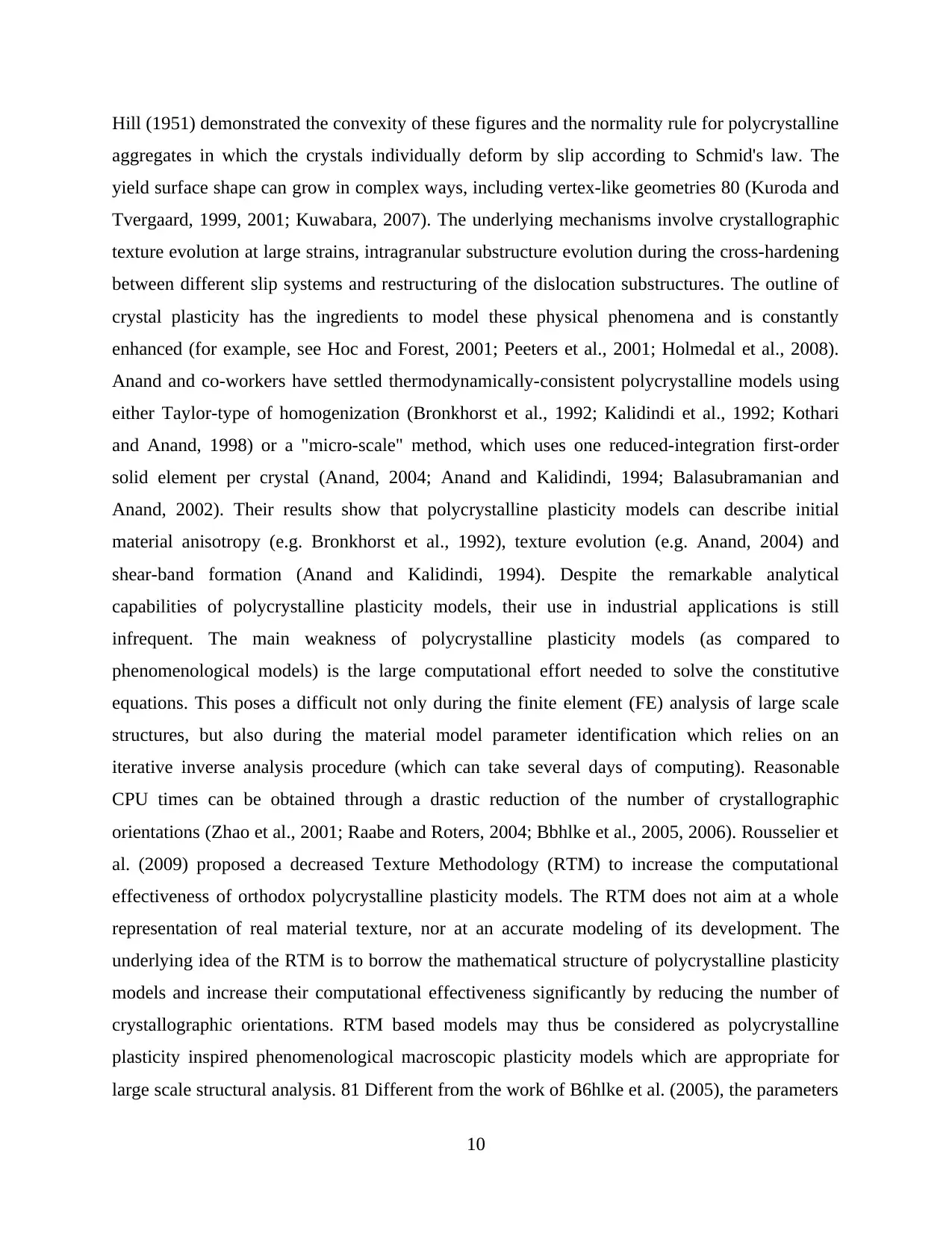
Hill (1951) demonstrated the convexity of these figures and the normality rule for polycrystalline
aggregates in which the crystals individually deform by slip according to Schmid's law. The
yield surface shape can grow in complex ways, including vertex-like geometries 80 (Kuroda and
Tvergaard, 1999, 2001; Kuwabara, 2007). The underlying mechanisms involve crystallographic
texture evolution at large strains, intragranular substructure evolution during the cross-hardening
between different slip systems and restructuring of the dislocation substructures. The outline of
crystal plasticity has the ingredients to model these physical phenomena and is constantly
enhanced (for example, see Hoc and Forest, 2001; Peeters et al., 2001; Holmedal et al., 2008).
Anand and co-workers have settled thermodynamically-consistent polycrystalline models using
either Taylor-type of homogenization (Bronkhorst et al., 1992; Kalidindi et al., 1992; Kothari
and Anand, 1998) or a "micro-scale" method, which uses one reduced-integration first-order
solid element per crystal (Anand, 2004; Anand and Kalidindi, 1994; Balasubramanian and
Anand, 2002). Their results show that polycrystalline plasticity models can describe initial
material anisotropy (e.g. Bronkhorst et al., 1992), texture evolution (e.g. Anand, 2004) and
shear-band formation (Anand and Kalidindi, 1994). Despite the remarkable analytical
capabilities of polycrystalline plasticity models, their use in industrial applications is still
infrequent. The main weakness of polycrystalline plasticity models (as compared to
phenomenological models) is the large computational effort needed to solve the constitutive
equations. This poses a difficult not only during the finite element (FE) analysis of large scale
structures, but also during the material model parameter identification which relies on an
iterative inverse analysis procedure (which can take several days of computing). Reasonable
CPU times can be obtained through a drastic reduction of the number of crystallographic
orientations (Zhao et al., 2001; Raabe and Roters, 2004; Bbhlke et al., 2005, 2006). Rousselier et
al. (2009) proposed a decreased Texture Methodology (RTM) to increase the computational
effectiveness of orthodox polycrystalline plasticity models. The RTM does not aim at a whole
representation of real material texture, nor at an accurate modeling of its development. The
underlying idea of the RTM is to borrow the mathematical structure of polycrystalline plasticity
models and increase their computational effectiveness significantly by reducing the number of
crystallographic orientations. RTM based models may thus be considered as polycrystalline
plasticity inspired phenomenological macroscopic plasticity models which are appropriate for
large scale structural analysis. 81 Different from the work of B6hlke et al. (2005), the parameters
10
aggregates in which the crystals individually deform by slip according to Schmid's law. The
yield surface shape can grow in complex ways, including vertex-like geometries 80 (Kuroda and
Tvergaard, 1999, 2001; Kuwabara, 2007). The underlying mechanisms involve crystallographic
texture evolution at large strains, intragranular substructure evolution during the cross-hardening
between different slip systems and restructuring of the dislocation substructures. The outline of
crystal plasticity has the ingredients to model these physical phenomena and is constantly
enhanced (for example, see Hoc and Forest, 2001; Peeters et al., 2001; Holmedal et al., 2008).
Anand and co-workers have settled thermodynamically-consistent polycrystalline models using
either Taylor-type of homogenization (Bronkhorst et al., 1992; Kalidindi et al., 1992; Kothari
and Anand, 1998) or a "micro-scale" method, which uses one reduced-integration first-order
solid element per crystal (Anand, 2004; Anand and Kalidindi, 1994; Balasubramanian and
Anand, 2002). Their results show that polycrystalline plasticity models can describe initial
material anisotropy (e.g. Bronkhorst et al., 1992), texture evolution (e.g. Anand, 2004) and
shear-band formation (Anand and Kalidindi, 1994). Despite the remarkable analytical
capabilities of polycrystalline plasticity models, their use in industrial applications is still
infrequent. The main weakness of polycrystalline plasticity models (as compared to
phenomenological models) is the large computational effort needed to solve the constitutive
equations. This poses a difficult not only during the finite element (FE) analysis of large scale
structures, but also during the material model parameter identification which relies on an
iterative inverse analysis procedure (which can take several days of computing). Reasonable
CPU times can be obtained through a drastic reduction of the number of crystallographic
orientations (Zhao et al., 2001; Raabe and Roters, 2004; Bbhlke et al., 2005, 2006). Rousselier et
al. (2009) proposed a decreased Texture Methodology (RTM) to increase the computational
effectiveness of orthodox polycrystalline plasticity models. The RTM does not aim at a whole
representation of real material texture, nor at an accurate modeling of its development. The
underlying idea of the RTM is to borrow the mathematical structure of polycrystalline plasticity
models and increase their computational effectiveness significantly by reducing the number of
crystallographic orientations. RTM based models may thus be considered as polycrystalline
plasticity inspired phenomenological macroscopic plasticity models which are appropriate for
large scale structural analysis. 81 Different from the work of B6hlke et al. (2005), the parameters
10
⊘ This is a preview!⊘
Do you want full access?
Subscribe today to unlock all pages.

Trusted by 1+ million students worldwide
1 out of 15
Your All-in-One AI-Powered Toolkit for Academic Success.
+13062052269
info@desklib.com
Available 24*7 on WhatsApp / Email
![[object Object]](/_next/static/media/star-bottom.7253800d.svg)
Unlock your academic potential
Copyright © 2020–2025 A2Z Services. All Rights Reserved. Developed and managed by ZUCOL.

